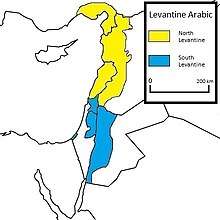North Levantine Arabic
| North Levantine Arabic | |
|---|---|
| اللهجة الشامي الشمال | |
| Native to | Lebanon, Syria, Chukurova (Turkey) |
Native speakers | 24.2 million (2014-2015)[1] |
|
Afro-Asiatic
| |
| Dialects | |
| Arabic alphabet | |
| Language codes | |
| ISO 639-3 |
apc |
| Glottolog |
nort3139[2] |
 | |
North Levantine Arabic (Arabic: اللهجة الشامي الشمال) is a subdivision of Levantine Arabic. It stems from the north in Turkey, specifically in the coastal regions of the Adana, Hatay, and Mersin provinces,[3][4] to Lebanon,[5][3] passing through the Mediterranean coastal regions of Syria (the Al Ladhiqiyah and Tartus governorates) as well as the areas surrounding Aleppo and Damascus.[3][6]
With over 24 million native speakers worldwide as of 2015,[3] Northern Levantine Arabic is used for daily speech mainly in Lebanon and Syria, while most of the written and official documents and media use Modern Standard Arabic.
Dialects
- Syria: Aleppine, Damascene[3]
- Lebanon: North Lebanese, South Lebanese (Metuali, Shii), North-Central Lebanese (Mount Lebanon Arabic), South-Central Lebanese (Druze Arabic), Standard Lebanese, Beqaa, Sunni Beiruti, Saida Sunni, Iqlim-Al-Kharrub Sunni, Jdaideh[3]
- Çukurova, Turkey: Cilician, Çukurovan[3]
See also
References
- ↑ "Arabic, North Levantine Spoken". Ethnologue. Retrieved 2018-08-08.
- ↑ Hammarström, Harald; Forkel, Robert; Haspelmath, Martin, eds. (2017). "North Levantine Arabic". Glottolog 3.0. Jena, Germany: Max Planck Institute for the Science of Human History.
- 1 2 3 4 5 6 7 "Arabic, North Levantine Spoken". Ethnologue. Retrieved 2018-07-16.
- ↑ "Turkey". Ethnologue. Retrieved 2018-07-16.
- ↑ "Glottolog 3.2 - North Levantine Arabic". glottolog.org. Retrieved 2018-07-16.
- ↑ "Jordan and Syria". Ethnologue. Retrieved 2018-07-16.
External links
This article is issued from
Wikipedia.
The text is licensed under Creative Commons - Attribution - Sharealike.
Additional terms may apply for the media files.